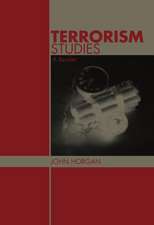The Geographical Dimensions of Terrorism
Editat de Susan L. Cutter, Douglas B. Richardson, Thomas J. Wilbanksen Limba Engleză Hardback – 28 feb 2003
| Toate formatele și edițiile | Preț | Express |
|---|---|---|
| Paperback (1) | 450.40 lei 6-8 săpt. | |
| Taylor & Francis – 28 feb 2003 | 450.40 lei 6-8 săpt. | |
| Hardback (1) | 1063.65 lei 6-8 săpt. | |
| Taylor & Francis – 28 feb 2003 | 1063.65 lei 6-8 săpt. |
Preț: 1063.65 lei
Preț vechi: 1297.14 lei
-18% Nou
Puncte Express: 1595
Preț estimativ în valută:
203.55€ • 211.22$ • 170.13£
203.55€ • 211.22$ • 170.13£
Carte tipărită la comandă
Livrare economică 17-31 martie
Preluare comenzi: 021 569.72.76
Specificații
ISBN-13: 9780415946414
ISBN-10: 0415946417
Pagini: 296
Dimensiuni: 152 x 229 x 25 mm
Greutate: 0.71 kg
Ediția:1
Editura: Taylor & Francis
Colecția Routledge
Locul publicării:Oxford, United Kingdom
ISBN-10: 0415946417
Pagini: 296
Dimensiuni: 152 x 229 x 25 mm
Greutate: 0.71 kg
Ediția:1
Editura: Taylor & Francis
Colecția Routledge
Locul publicării:Oxford, United Kingdom
Recenzii
"This book is to be recommended, as it offers another toolbox to those of us concerned with terrorism and its impact on our lives.
." -- Stephane Lefebvre, formerly with the Department of National Defence, Canada, H-Net Reviews
." -- Stephane Lefebvre, formerly with the Department of National Defence, Canada, H-Net Reviews
Cuprins
Figures Tables Acknowledgements Foreword, John H. Marburger Introduction, Philip Rubin Chapter 1: The Changing Landscape of Fear, Susan L. Cutter, Douglas B. Richardson and Thomas J. Wilbanks Chapter 2: Societal Responses to Threats Introduction 2.1 Public Health, Law Enforcement, and Hazards Management, Deborah S. K. Thomas 2.2 Urban Vulnerability to Terrorism as Hazard, James K. Mitchell 2.3 Emergency Preparedness and Response--Lessons Learned from 9/11, Gerald E. Galloway 2.4 Transborder Disaster Management, Richard Wright, Paul Ganster and David Dow Chapter 3: Understanding the Root Causes of Terrorism Introduction 3.1 The Space of Terror, Alexander B. Murphy 3.2 Geographies of Inclusion/Exclusion, Colin Flint 3.3 Drug Production, Commerce, and Terrorism, Kent Mathewson and Michael Steinberg 3.4 Insurrections, Marilyn Silberfein Chapter 4: Geospatial Data and Technologies in Times of Crises Introduction 4.1 The Need for a National Spatial Data Infrastructure, Mike Tait 4.2 Remote Sensing Imagery for Emergency Management, Andrew J. Bruzewicz 4.3 Geospatial Data in Emergencies, Michael F. Goodchild 4.4 Data Modeling for Emergencies, Michael F. Goodchild 4.5 Intelligent Emergency Response Systems, Mei-Po Kwan 4.6 Geographic Management Systems for Homeland Security, Frederick Abler and Douglas B. Richardson Chapter 5: Vulnerability of Lifelines, the Built Environment, and People Introduction 5.1 Critical Infrastructure, John A. Kelmelis and Scott A. Loomer 5.2 Energy Systems and Infrastructures, Thomas J. Wilbanks 5.3 Transportation and Communication Lifelines Disruption, Harvey J. Miller 5.4 Economic Assessment of Unexpected Events, Geoffrey J. D. Hewings and Yasuhide Okuyama 5.5 Estimating Populations at Risk, Jerome E. Dobson 5.6 Recreating Secure Spaces, Ray J. Dezzani and T. R. Lakshmanan Chapter 6: Bioterrorism Introduction 6.1 Understanding Biological Warfare, Arthur Getis 6.2 Bioweaponry and Agroterrorism, Lisa M. Butler Harrington 6.3 Spatial Surveillance of and Response to Biological Threats, Marilyn O. Ruiz Chapter 7: Building a Safer but Open Society Introduction 7.1 Openness versus Security of Geographic Information, Harlan Onsrud 7.2 GeoSecurity, William B. Wood Chapter 8: A Research and Action Agenda, Susan L. Cutter, Douglas B. Richardson and Thomas J. Wilbanks Epilogue, Jack Dangermond References Contributors
Notă biografică
Susan L. Cutter, Douglas B. Richardson, Thomas J. Wilbanks

























